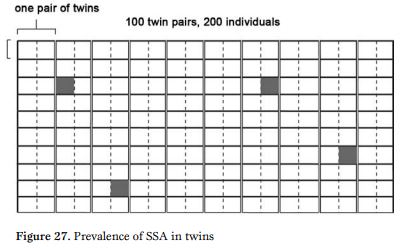Is Homosexuality Genetic?
Twin Studies: Is Homosexuality Genetic?
Written By: Dr. Neil Whitehead ( http://www.mygenes.co.nz/ ) - whiteh@paradise.net.nz
Over the last decade, studies of twins have provided some of the strongest numerical evidence that “Our genes do not make us do it”— which makes this chapter probably the most important in the book. Results from twin studies are quantitative, so they greatly focus and sharpen the results of many other studies we’ve mentioned so far. In a nutshell, if you take pairs of identical twins in which one twin is homosexual, the identical co-twin (a monozygotic (MZ) twin) is usually not homosexual. That means, given that identical twins are always genetically identical, homosexuality cannot be genetically dictated. No-one is born gay.
The predominant things that create homosexuality in one identical twin and not in the other have to be post-birth factors. Hold on to this simple thought as you navigate the complex world of twin studies in the pages of this chapter. Four other points to take note of on the way through: • Saying a trait is, e.g., 10% “genetic” is nothing extraordinary. There is at least a 10% genetic effect in anything humans are and do, simply because without bodies we can’t act in the environment at all. “Genetic” effects are experienced by everyone because we all have bodies.
So homosexuality is like any other human trait • Any genetic effects are mostly quite indirect • For SSA they are weak • They become relatively less important in the face of contrary environmental input • There is also good news in this chapter for parents who (usually mistakenly) hold themselves responsible for homosexuality in their children, either genetically or socially
Twin studies
Twins have been invaluable to medical research for a long time, though sometimes in lethal ways. Twin study research probably reached its nadir during the Second World War, when Josef Mengele, a researcher at the Auschwitz concentration camp, deliberately sought out identical twins for experiments. Sometimes he would kill one twin by poisonous injection, dissect that twin to see its effects, then immediately kill the co-twin to see the differences.
The founders of twin studies were very frequently involved in Third Reich theories of Aryan racial superiority and supporters of ethnic cleansing. Today twin studies are used constructively. By September 2013, about 50,000 scientific papers in medical databases mentioned twins and new papers are being published at the rate of a few thousand a year.
Traditionally, twin studies first compare identical twins to gauge the effects of genetics (a high similarity probably means high genetic influence), and then quickly add non-identical twins (fraternal/ dizygotic (DZ) twins), to give extra information about the relative importance of upbringing.*
Concordance for SSA
Twin registers are the foundation of modern twin studies. They are now very large, and exist in many countries. A gigantic European twin register with a projected 600,000 members is being organised, but a few registers already have more than 33,000 pairs of twins on the books, all of whom are prepared to assist in general research.
If we use a register of identical (MZ) twins and find pairs in which one twin has SSA, we can then see if the other twin does or does not have SSA. This finding gives what is called the pairwise concordance. Readers should note that twin researchers often use a different measure without explanation or warning, called the probandwise concordance. This is a much less intuitive measure, needed for classical twin study calculations. It is often much higher than the pairwise concordance and when used without explanation, can give the impression that genetic influence is much higher for the trait under study than it actually is. The pairwise concordances in this chapter answer in an intuitive way the simple question—if one twin of an identical pair is SSA, what percentage of co-twins are also SSA?
Jones and Yarhouse, for the important Australian Bailey et al. (2000)3 SSA twin study paper, find that for self-declared lesbians and gays the pairwise concordance is 14% and 11% respectively. This means that for every nine sets of male identical (MZ) twins, one of whom is homosexual, the other is homosexual only one time in nine, or 11% of the time, which is not very much. That is, identical twins usually differ.
Anyone can verify this in the original paper. Five, mostly later very large studies, gave very similar results. The pattern is similar for males and females, and looks like Figure 26.
What 11% concordance means
What does what 11% concordance mean?
It does not mean that 11% of identical twins have SSA. Numerous studies of western populations have shown that homosexuality (including bisexuality) is present in something between 2-3% of people, and this, of course, includes twins, e.g., Figure 27 shows 100 hypothetical twin pairs taken from a twin registry. Of those 200 individuals only 4 (roughly 2-3% of them) [shown by the grey squares] have SSA, but all are discordant. There are not enough pairs to show the rarer pairs both of whom have SSA and are therefore concordant.
Nor does 11% concordance mean for any concordant pair, that they only, and none of the other twin pairs, are affected by genetic factors. All the twins (and everybody else in the world for that matter) are equally exposed to genetic effects, environmental effects and chance.
Nor does 11% concordance mean that homosexuality is genetically inevitable for 11% of the homosexual population. Eleven per cent concordance simply shows that when one of a twin pair from a general twin registry is homosexual, his co-twin is homosexual one time in nine, or 11% of the time.
Twin studies give information about family environments
It’s also important to emphasize that in twin studies concordance is not only a kind of catch-all for any biological factors in common, e.g., things like biological environment before birth, but also for common post-birth environmental factors. Identical twins not only have identical genes, but they (usually) grow up in the same family environment. So Figure 26 illustrates the combined effects of a shared genetic inheritance and a shared home environment. (This is rather ambiguous but we shall see it still gives crucial information in the case of SSA.) At only 11% concordance we have to say that at first sight for SSA, it seems that neither genes nor upbringing is very important. Put another way, in homosexuality the practical effect of genes, other shared pre-natal biological factors, and a shared home environment, is weak. (More about the shared family environment later.) So if shared factors are not important what is? In SSA it is non-shared factors: things happening to one twin but not the other, or a personal response to an event by one of the twins and not the other (that response having far-reaching effects.)
We will call this non-shared fraction, the random or chance factor and for SSA, on this basis, it is 89%.
We also want to emphasize that the use of pairwise concordances we are making here is for illustration not for proof. To get a more accurate picture you also need to consider how often SSA occurs in the general population and/or what the concordance is for fraternal twins (see Section Two, on classic twin studies.) However the fundamental point will remain true: the largest single cause of SSA is random factors (meaning, factors affecting one twin but not the other).
Same-sex attraction is not inborn
We can now make our most important point: Those with SSA are not born that way. If factors in common like genetics or conditions in the womb overwhelmingly cause SSA, then identical twins will always be identical for SSA, i.e., the SSA concordance would be 100%. But Chapter Ten: Twin studies - the strongest evidence 175 they are not 100% concordant for SSA, so it is clear that post-natal random factors are mostly responsible for SSA. We could also sum up Figures 26-27 by saying that for SSA genes create a tendency, not a tyranny. Even the tendency is weak. This is a critically important principle.
In the discussion here we concentrate on adults and postpone until Chapter Twelve the implications of even lower SSA concordances in identical adolescent twin students in the 2002 paper on SSA by Bearman and Brueckner.4 **
Twin studies cover all possible shared biological influences—known and unknown
Our second important point is that because “genetic” in twin studies includes everything from the shared biological environment (Figure 26), twin studies reflect all genetic/biological influences, those known and those not yet known. It is a statement of the realities no matter how many details have yet to be scientifically discovered. And many more details will be discovered as scientific papers continue to find new factors at the rate of about one every year. Remarkably, twin studies summarise all the shared biological effects on developing twin embryos that will ever be discovered. And, to repeat: at 11% the combined genetic effects are weak for SSA.
This degree of concordance now has the backing of half a dozen major twin studies so is very unlikely to change. So the following conclusion will not change in the future either:
The predominant cause of SSA both in men and women is individual post-natal random reactions to biological and environmental factors.
As clear as this conclusion is, it has not been foremost in the thinking of academics because research has tended to concentrate on the question, “Is SSA genetic?” and this has diverted attention from the individual erratic factors.
SSA concordance compared with concordance for other conditions/traits
In Figure 28 we compare the degree of pairwise concordance for SSA with pairwise concordance for other traits and conditions, to give some perspective. We concentrate on low concordance conditions. On the left is lung cancer with an almost zero concordance. This means that if one MZ twin has it, the co-twin almost always does not. This illustrates that neither common environment nor genetics is responsible for lung cancer, but chance or random factors.
SSA at only 11% concordance is therefore strongly dominated (89%) by chance. Few other conditions produce such MZ twin differences except the cancers, stroke and criminality (not shown).
This conclusion should be spelt out again in a slightly different form: the largest factor in SSA twin studies is non-shared influences, i.e., random or chance events: things happening to one twin but not the other, or different perceptions of, e.g., upbringing or a one-off event, causing it to have special significance for one but not the other.
Left-handedness has a 13.5% concordance similar to that of SSA. A sensitive large study could not find any contributing genes, at least for simple models. Left-handedness is still overwhelmingly due to non-shared environment—chance.22 This book proposes the same for SSA.
Gene penetrance
Poor gene penetrance is a red herring
An argument sometime advanced to explain low concordance in twin studies for SSA is poor gene penetrance. This holds that there is a single gene which is important and responsible for the trait but for unknown reasons (probably connected to cell biochemistry) it does not exert its effects in those without the trait. Sir Michael Rutter says “Penetrance is not very usual for single gene effects.”21 A check of the largest database on penetrance showed that this might happen for a single gene in about 10% of cases only. The poor penetrance argument involves three layers of speculation:
- that SSA genes exist;
- that they are switching off in one twin and not the other
- that the penetrance effect is unusually weak for SSA compared with other traits
Low penetrance is no explanation for low pairwise concordances. Rather, from the perspective of our best present knowledge, the effects of genes and shared environment are low, and random events dominate.
Summary
One thing seems clear: any genetic contribution to SSA is much less than in most traits for which genetic influence has been measured. SSA seems 90% a result of random factors. SSA is in fact a good example of not being “born that way”!
Higher SSA concordances from pre-register studies (before 2000) are now agreed to have resulted from an unusual degree of “volunteer error” and are often given as probandwise concordance (see p172 on ), which is considerably higher than the 11% result.
It is also salutary to note that the better the twin sample, the lower the SSA concordance, i.e., the lower the genetic influence. In other words volunteer bias greatly exaggerated those early results, which are unfortunately still quoted widely.
Some might expect concordances for male SSA to be different from concordances for lesbianism, but concordance for both men and women is unusually low. At 11%-14% this suggests that shared genetic and environmental factors are weak in both cases and that something else is going on. Again we say this is idiosyncratic responses to random/chance factors.
Minimal effect of family environment
A second feature of these pairwise MZ twin study data is the apparent minor effect of family environment (upbringing) on the development of SSA. Both shared biological effects and common family environment added together produce only an 11%-14% pairwise concordance. Fuller studies, which include DZ twins, also usually show that for SSA the effect of upbringing is low and even less than that of genes. Parents take note: according to twin studies of SSA, you are usually not directly involved in making a son or daughter gay, either genetically or through parenting.
Those who know classical twin study results will immediately recognize a common pattern. Results from twin studies for very many traits show family influence is less than genetic influence. However lack of family influence is a controversial issue. Developmental psychologists didn’t believe it—they noticed many obvious effects of family environment in their clinics.
A representative view is held to therapist Oliver James: Twin Studies: a Discredited Method. But the twin studies experts stuck to their statistical conclusions, and argued that the third factor, randomness (in our terms individual reactions to chance events) is even more important than genes or family. They then found that many shared family influences were hidden in that random group, so family effects only seem very small but they are hard to separate from the true random effects.
Full book: http://www.mygenes.co.nz/mgmmdi_pdfs/2016_MGMMDI_opt.pdf







